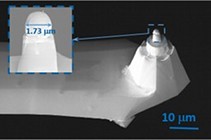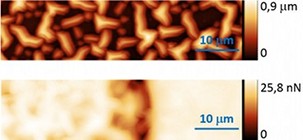|
CPM SeminarLocal force mapping of an NdFeB micro-magnet arrays using a custom-made Microparticle MFM probeFlorence MarchiGrenoble Alpes University & Néel Institute/CNRSPermanent NdFeB or SmCo micro-magnet arrays fabricated by a thermo-magnetic process [1] produce high stray magnetic field gradients (up to 106 T/m). They have been implemented successfully into microfluidic devices as a key component to separate magnetic and non-magnetic microspheres [2] as well as to trap biological cells tagged with magnetic nanoparticles [3]. In biology and medicine, the interest for this kind of devices is growing because of their practical importance in stem cell research, cancer diagnostics and cell therapeutics [3] for isolation and sorting of target cells from heterogeneous suspensions. Since the magnetic force exerts on an object is determined by both its magnetic properties (moment and volume) and the magnetic field it experiences, reliable magnetic force measurements at micro and nanoscale are required to study the impact of the sample magnetic fields properties (intensity, homogeneity and spatial extension) on the object according to its magnetic properties. In addition, as the magnetic tag can have toxicity effects on living biological species, its optimization is crucial according to the design of the sorting device. In this work, we report quantitative measurements of the forces exerted by a micro-magnet array on a magnetic microparticle, based on Magnetic Force Microscopy. Firstly, two methods were developed to fix a single super-paramagnetic microparticle (polystyrene sphere functionalized with FeO nanoparticles) on the tip apex of silicon AFM probe. The first method exploits AFM capabilities in frequency measurements, weak force interaction detection and imaging, to adjust the quantity of glue on the tip and to localize, select and fix a single magnetic microsphere to form a so-called particle probe [4]. The second method exploits capabilities of a dual beam FIB/SEM machine equipped with a micromanipulator. As a result, smart MFM probes (fig.1) where all the magnetic material concentrated in the microparticle, are obtained. MFM measurements were then performed in air to localize the magnetic traps (i.e. the interfaces between areas with initial and reversed orientation of magnetization) and to measure the force and its gradient induced by the micro-magnets on the magnetic microsphere. For the MFM operation, a standard two-pass technique has been used [5] in dynamic and in contact modes, where the offset elevation (often called "lift height") was varied from 300nm up to 3500nm. MFM maps obtained in dynamic mode reveal that the force gradient is always positive while MFM maps obtained in contact mode reveal attractive forces with an intensity ranging from 7-25nN and 0.5-5nN, for microspheres of diameter 3.5μm and 1.45μm, respectively. These experiments constitute the first direct and quantitative characterization of the magnetic interaction between a superparamagnetic microsphere and the micro-magnets [4]. Similar measurements have been carried out using ferromagnetic microparticles to study the impact of high magnetic moment on the trapping process. Such MFM characterization combined with simulations can feed back into the design of micro-magnet arrays and microfluidic devices developed for the trapping of objects functionalized with magnetic nanoparticles.  Figure 1. SEM image of a particle probe.  Figure 2. Topography and MFM images of a micromagnet array obtained with a 3.5�m colloidal probe at a Lift Height of 500nm.
[1] F. Dumas-Bouchiat et al.,
“Thermomagnetically patterned micromagnets”,
Appl. Phys. Lett. 96, 102511 (2010).
Thursday, September 17th 2015, 15:30
Ernest Rutherford Physics Building, R.E. Bell Conference Room (room 103) |